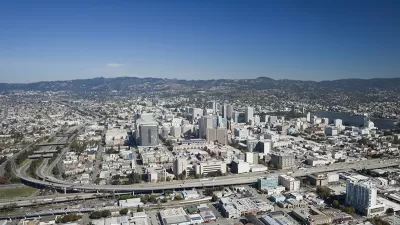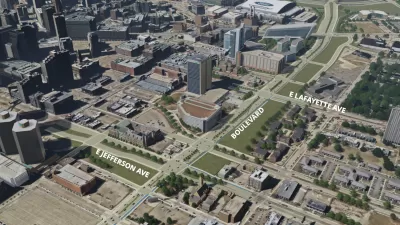A grassroots, ambitious vision called Connect Oakland is gaining steam in the East Bay city. The key element of the plan's ambition: replacing the I-980 Freeway with an urban boulevard and new housing.

John King explains the details of the so-called Connect Oakland plan, a proposal gaining political support in Oakland City Hall to remove the I-980 Freeway—"a broad swath of landscaped asphalt that separates residential West Oakland from the city’s downtown."
According to King, the plan would replace the freeway with "a boulevard lined with housing at all price levels, reknitting the urban landscape." The proposal could also "include space for BART beneath the boulevard, a tunnel that could connect to a second BART tube from Oakland to San Francisco."
Throughout the article, King, the San Francisco Chronicle's urban design critic, provides the historic context of the construction of I-980 and of the precedent set by freeway removals in the Bay Area. King describes Octavia Boulevard in San Francisco, for example, as a comparable example for the future direction of Connect Oakland.
The proposal has been pressed "for the past year by a handful of local architects and planners with good intentions but little clout," reports King, but city recently moved the idea into a new level of legitimacy when it requested "requested $5.2 million from the Alameda County Transportation Authority to begin planning studies of an I-980 conversion and a second BART tube."
As for King's take on the idea, he clearly approves of the spirit of the effort, proclaiming: "I-980 is a relic ripe for change, and its future shouldn’t be taken for granted."
FULL STORY: Oakland moving in right direction with idea to replace I-980

Maui's Vacation Rental Debate Turns Ugly
Verbal attacks, misinformation campaigns and fistfights plague a high-stakes debate to convert thousands of vacation rentals into long-term housing.

Planetizen Federal Action Tracker
A weekly monitor of how Trump’s orders and actions are impacting planners and planning in America.

In Urban Planning, AI Prompting Could be the New Design Thinking
Creativity has long been key to great urban design. What if we see AI as our new creative partner?

King County Supportive Housing Program Offers Hope for Unhoused Residents
The county is taking a ‘Housing First’ approach that prioritizes getting people into housing, then offering wraparound supportive services.

Researchers Use AI to Get Clearer Picture of US Housing
Analysts are using artificial intelligence to supercharge their research by allowing them to comb through data faster. Though these AI tools can be error prone, they save time and housing researchers are optimistic about the future.

Making Shared Micromobility More Inclusive
Cities and shared mobility system operators can do more to include people with disabilities in planning and operations, per a new report.
Urban Design for Planners 1: Software Tools
This six-course series explores essential urban design concepts using open source software and equips planners with the tools they need to participate fully in the urban design process.
Planning for Universal Design
Learn the tools for implementing Universal Design in planning regulations.
planning NEXT
Appalachian Highlands Housing Partners
Mpact (founded as Rail~Volution)
City of Camden Redevelopment Agency
City of Astoria
City of Portland
City of Laramie





























